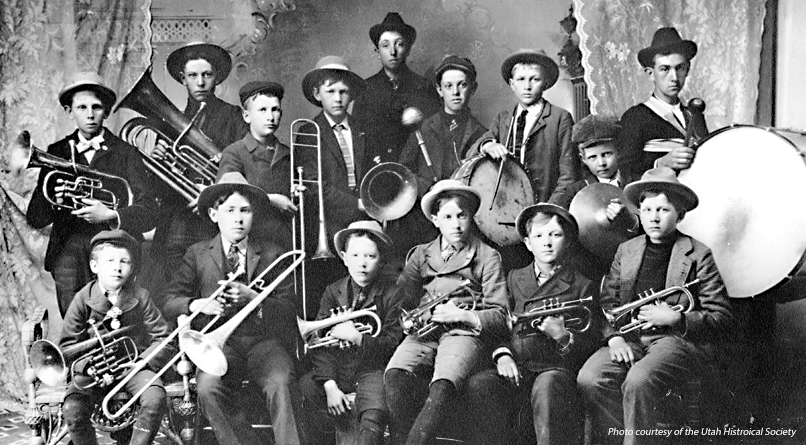
“It is hard for [21st-century] Americans to imagine a world in which there was no music except what people produced for themselves. At the end of the 19th century, nearly every town in the Utah Territory, from Grouse Creek to Mammoth and Brigham City to Santa Clara, had their own brass band. Some estimates have the total number of brass bands as high as 200 at the turn of the 20th century.
“Perhaps nowhere was the brass band more appreciated than in pioneer Utah, where scores of bands were organized as settlements gradually filled the Territory from one end to the other … The Mormons were a particularly musical people, and it was probably true, as John Hyde observed, that ‘every third man in Utah was a fiddler.’ In their beleaguered exodus from Illinois to the Rocky Mountains, with room in wagons and carts for only the most precious of belongings, the pioneers brought several bands virtually intact, including the Nauvoo Legion Band and William Pitt’s Brass Band. Once in Utah, settlements were carefully organized to include people with musical skills. Music made life tolerable in the isolated mountain and desert valleys, hundreds of miles from nowhere.” - Notes for “Brassworks’ Centennial Band,” Dr. Roger Miller, former professor of music, University of Utah(Click here for additional information)
Lehi Brass Band: In 1871, the Lehi Brass band was organized by 28-year-old school teacher George William Thurman. Thurman had served in the Kentucky Home Guard Band during the Civil War. Tragedy struck that same year when Thurman was murdered by band member Jed Thurman, who he had earlier “chastised.” The murder took place in a church building as Thurman was putting up Christmas decorations for a celebration and concert. Later, the band “serenaded LDS Church President Brigham Young, Apostles George Q. Cannon and John Taylor, and other important church leaders when they visited Lehi in 1874.” (Utah Historical Quarterly, Volume 74, Number 1, 2006)
Plain City Brass Band: One year (though the date was not recorded, probably in the 1880s), the Plain City Brass Band marched from Plain City to the Weber River with all the residents in wagons or on foot marching behind. The band consisted of two cornets, two alto horns, two tenor horns, one baritone, one tuba, a snare drum and a bass drum. A dance followed the celebration. On one occasion, the Plain City Band baseball team “arranged to play a team in Logan, followed by the usual band concert …. During the game, it was learned that the bodies of two Mormon missionaries from Hyrum, who had been killed by mobs in Tennessee, were due to arrive by train in Logan. The Plain City and Logan bands walked to the depot to meet the train, and then marched at the head of the funeral procession to Main Street, where the solemn cortege passed before the gathered crowd of mourners.” (Dr. Roger Miller)
Pitt’s Brass Band/Nauvoo Brass Band: This band, originally called Joseph’s City Band, was officially titled the Nauvoo Brass Band, but everyone called it Pitt’s Brass Band after William Pitt, the original organizer. After the murders of Joseph and Hyrum Smith, the band met the wagon carrying their bodies and march in front as the procession moved through the city.
As the members of The Church of Jesus Christ of Latter-day Saints prepared to leave Nauvoo, Illinois, in 1846, the band tried to stay together to make the journey west. They accompanied Brigham Young and played along the trail as well as for many settlements in Iowa. They had to split up along the way, but eventually all the band members made it to the Salt Lake Valley. They performed at the October General Conference in 1848. They played for many Pioneer Day celebrations and for the laying of the cornerstones of the Salt Lake Temple in 1853. They also met the first handcart pioneer company as well as other groups as they entered the Salt Lake Valley.
